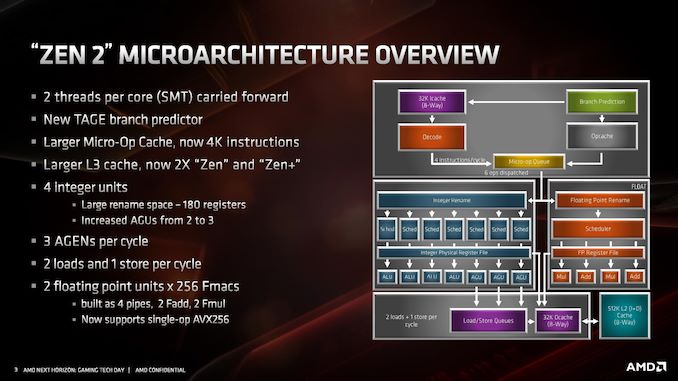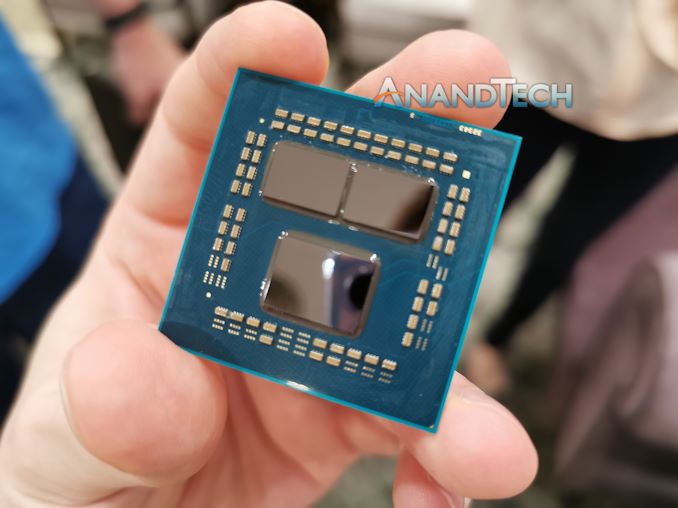AMD Zen 2 Microarchitecture Analysis: Ryzen 3000 and EPYC Rome
by Dr. Ian Cutress on June 10, 2019 7:22 PM EST- Posted in
- CPUs
- AMD
- Ryzen
- EPYC
- Infinity Fabric
- PCIe 4.0
- Zen 2
- Rome
- Ryzen 3000
- Ryzen 3rd Gen
Building a core like Zen 2 requires more than just building a core. The interplay between the core, the SoC design, and then the platform requires different internal teams to come together to create a level of synergy that working separately lacks. What AMD has done with the chiplet design and Zen 2 shows great promise, not only in taking advantage of smaller process nodes, but also driving one path on the future of compute.
When going down a process node, the main advantages are lower power. That can be taken in a few ways: lower power for operation at the same performance, or more power budget to do more. We see this with core designs over time: as more power budget is opened or different units within the core get more efficient, that extra power is used to drive cores wider, hopefully increasing raw instruction rate. It’s not an easy equation to solve, as there are many trade-offs: one such example in the Zen 2 core is the relationship between the reduced L1 I-cache that has allowed AMD to double the micro-op cache, which overall AMD expects to help with performance and power. Going into the minutae of what might be possible, at least at a high level, is like playing with Lego for these engineers.
All that being said, Zen 2 looks a lot like Zen. It is part of the same family, which means it looks very similar. What AMD has done with the platform, enabling PCIe 4.0, and putting the design in place to rid the server processors of the NUMA-like environment is going to help AMD in the long run. The outlook is good for AMD here, depending on how high it can drive the frequency of the server parts, but Zen 2 plus Rome is going to remove a good number of questions that customers on the fence had about Zen.
Overall AMD has quoted a +15% core performance improvement with Zen 2 over Zen+. With the core changes, at a high level, that certainly looks feasible. Users focused on performance will love the new 16-core Ryzen 9 3950X, while the processor seems nice an efficient at 105W, so it will be interesting so see what happens at lower power. We're also anticipating a very strong Rome launch here over the next few months, especially with features like double FP performance and QoS, and the raw multithreading performance of 64 cores is going to be an interesting disruptor to the market, especially if priced effectively. We’ll be getting the hardware on hand here soon to present our findings when the processors are launched on July 7th.












216 Comments
View All Comments
Targon - Thursday, June 13, 2019 - link
The TDP figures are always a bit vague, because it is about the heat generation, not about power draw. A higher TDP on a chip with the same number of cores on the same design could indicate that it will overclock higher. Intel always sets the TDP to the base clock speed, while AMD has been more about what can be expected in normal usage. The higher the clock speed, the more power will be required, and the higher the amount of heat will be that needs to be handled by the cooler.So, if a chip has a TDP of 105W, then in theory, you should be able to get away with a cooler that can handle 105W of heat output, but if that TDP is based only on the base clock speed, you will want a better cooler to allow for turbo/boost for sustained periods.
wilsonkf - Monday, June 10, 2019 - link
We want faster memory for Zen/Zen+ because we want higher IF clock, so cutting the IF clock by half to enable higher memory freq. does not make sense. However the improved IF could move the bottleneck somewhere else.AlexDaum - Tuesday, June 11, 2019 - link
It seems like IF2 can not hit frequencies higher than about 3733MHz DDR (so 1,8GHz real frequency) for some reason, so they added the ability to scale it down to have higher memory clocks. But it is probably only worth it if you can overclock memory a lot higher than 3733, so that the IF clock gets a bit higher againXyler94 - Tuesday, June 11, 2019 - link
If I recall, IF2's clock speed is decoupled from RAM speed.Cooe - Tuesday, June 11, 2019 - link
This is wrong Xyler. Still completely connected.Xyler94 - Thursday, June 13, 2019 - link
Per this exact Article:"One of the features of IF2 is that the clock has been decoupled from the main DRAM clock. In Zen and Zen+, the IF frequency was coupled to the DRAM frequency, which led to some interesting scenarios where the memory could go a lot faster but the limitations in the IF meant that they were both limited by the lock-step nature of the clock. For Zen 2, AMD has introduced ratios to the IF2, enabling a 1:1 normal ratio or a 2:1 ratio that reduces the IF2 clock in half."
It seems it has been, but it may still benefit from faster RAM still
extide - Monday, June 17, 2019 - link
It is completely connected -- you can just pick a 1:1 or 2:1 divider now but they are absolutely still tightly coupled. YOu can't just set them independently.Cooe - Tuesday, June 11, 2019 - link
You're missing the point for >3733MHz memory overclocked where the IF switches to a 2:1 divider. It's for workloads that highly prioritize memory bandwidth over latency, NOT to try and run your sticks 24/7 at like 5GHz+ for the absolute lowest latency possible (bc even then, 3733MHz will prolly still be lower).Targon - Thursday, June 13, 2019 - link
From what I remember, up to DDR4-3733, Infinity Fabric on Ryzen 3rd generation is now at a 1:1(where previously, Infinity Fabric would run at half the DDR4 speed. You can go above that, but then the improvements are not going to be as significant. For latency, your best bet is to get 3733 or 3600 with as low a CAS rating as you can get.zodiacfml - Tuesday, June 11, 2019 - link
that 105W TDP is a sign that the 8 core is efficient at 50W or a base clock of 3.5 GHz. The AMD 7nm 8-Core Zen 2 chip has a TDP equal or less than my i3-8100.😅